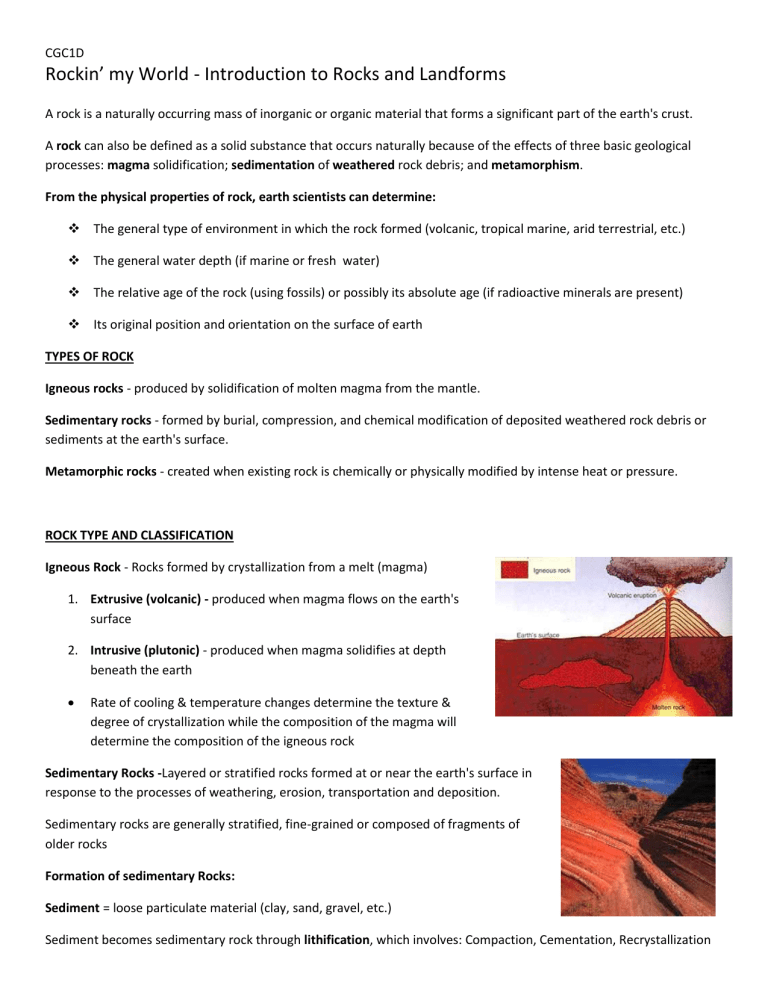File

CGC1D
Rockin’ my World - Introduction to Rocks and Landforms
A rock is a naturally occurring mass of inorganic or organic material that forms a significant part of the earth's crust.
A rock can also be defined as a solid substance that occurs naturally because of the effects of three basic geological processes: magma solidification; sedimentation of weathered rock debris; and metamorphism.
From the physical properties of rock, earth scientists can determine:
The general type of environment in which the rock formed (volcanic, tropical marine, arid terrestrial, etc.)
The general water depth (if marine or fresh water)
The relative age of the rock (using fossils) or possibly its absolute age (if radioactive minerals are present)
Its original position and orientation on the surface of earth
TYPES OF ROCK
Igneous rocks - produced by solidification of molten magma from the mantle.
Sedimentary rocks - formed by burial, compression, and chemical modification of deposited weathered rock debris or sediments at the earth's surface.
Metamorphic rocks - created when existing rock is chemically or physically modified by intense heat or pressure.
ROCK TYPE AND CLASSIFICATION
Igneous Rock - Rocks formed by crystallization from a melt (magma)
1.
Extrusive (volcanic) - produced when magma flows on the earth's surface
2.
Intrusive (plutonic) - produced when magma solidifies at depth beneath the earth
Rate of cooling & temperature changes determine the texture & degree of crystallization while the composition of the magma will determine the composition of the igneous rock
Sedimentary Rocks -Layered or stratified rocks formed at or near the earth's surface in response to the processes of weathering, erosion, transportation and deposition.
Sedimentary rocks are generally stratified, fine-grained or composed of fragments of older rocks
Formation of sedimentary Rocks:
Sediment = loose particulate material (clay, sand, gravel, etc.)
Sediment becomes sedimentary rock through lithification, which involves: Compaction, Cementation, Recrystallization
CGC1D
Characteristics of Sedimentary Rocks
Stratified because the sediments are laid down in horizontal layers called strata
May also contain fossil i.e: remains, prints or other indications of plants & animals found buried in rocks
Metamorphic Rocks
"Metamorphism" comes from the Greek: Meta = change, Morph = form, so metamorphism means to change form.
refers to the changes in mineral composition and texture that result from subjecting a rock to pressures and temperatures
Characteristics of Metamorphic Rocks:
Harder and more compact than the rock they are made from.
Minerals are arranged in bands or recrystallised to form new or larger minerals
Do Rocks Always Stay the Same?
• James Hutton: a farmer and Scottish geologist developed the concept of the rock cycle.
• He proposed that rock changes from one form to another over time, the matter making up rocks is neither created nor destroyed but simply changed
How does it work?
• Most surface rocks started out as igneous rocks- rocks produced by crystallization from a liquid.
• When igneous rocks are exposed at the surface they are subject to weathering
• Erosion moves particles into rivers and oceans where they are deposited to become sedimentary rocks.
• Sedimentary rocks can be buried or pushed to deeper levels in the Earth, where changes in pressure and temperature cause them to become metamorphic rocks.
• At high temperatures metamorphic rocks may melt to become magma.
• Magma rises to the surface, crystallize to become igneous rocks and the processes starts over.
So why does this matter?
• Knowledge of rocks fundamental to study of earth sciences
• Forms the basis for the study of plate tectonics








